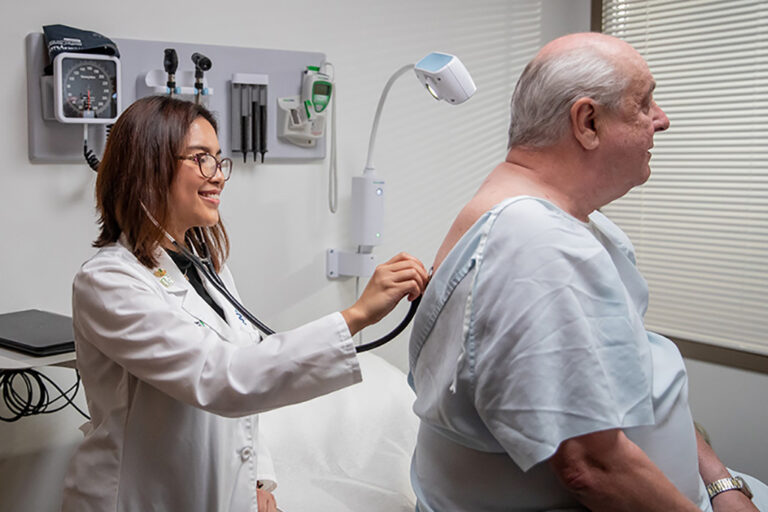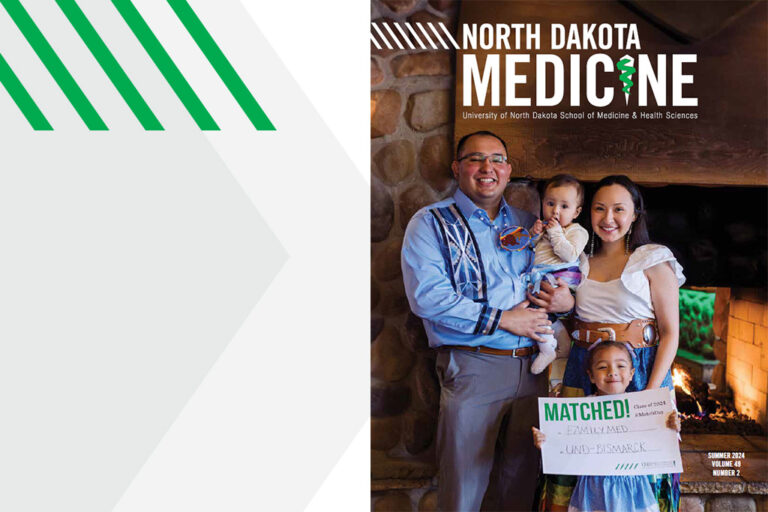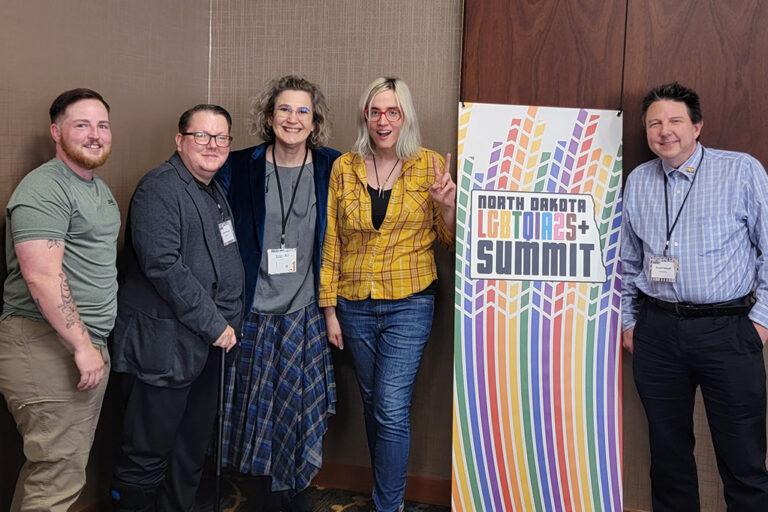Seeking health equity through service learning
UND’s medical students and Department of Geriatrics bring care to underserved populations in Grand Forks via the Health Promotion Program.
The idea is deceptively simple: what if, to enhance their patient care and communication skills in advance of their clinical training, UND School of Medicine & Health Sciences medical students go to where the patients are . . . and talk to them?
This easy-once-you-think-of-it concept is what prompted UND medical students Emilee Ohman and Chloe Bakkum to establish, with assistance from UND’s Department of Geriatrics, the Health Promotion Program (HPP) in Grand Forks.
“We felt that if we can equip med students with those communication skills in phase one, before they even get to their clinical rotations, they can just build on those skills in the clinic and really master them when they’re on their own,” explained Ohman, a Grand Forks, N.D., native and head of the medical students’ Geriatrics Interest Group. “Students have responded positively. They feel like they’ve gotten better at communicating with patients, which plays into our focus on being patient-centered – letting patients drive the conversation instead of us talking at them.”
Promoting better health
To be clear, these medical students are not treating human patients. What they are doing is chatting with residents of Grand Forks Housing Authority (GFHA) apartments about their previous experiences with the health system, their goals for improving their personal health, and strategies for addressing their needs with area providers.
That is to say: because the UND School of Medicine & Health Sciences is a community-based school, meaning it does not own or operate its own hospital or clinic in Grand Forks, students and faculty are limited in how they engage individual patients directly.
What they can do is address community healthcare needs – and disparities between populations – more broadly. The HPP’s solution to those needs was to establish a free health discussion group at a location closer to those whose health needs are likely going unmet consistently. That location, the Link, is a space within one GFHA complex adjacent to downtown Grand Forks.
Meeting with GFHA residents at the Link weekly since September 2023, student volunteers talk with residents about health and healthcare, answering questions and directing residents to resources as appropriate.
“I worked in a homeless healthcare clinic in Fargo, so I have a pretty good idea of what services are out there,” said Bakkum, who performed inpatient psychiatric care for several years before starting medical school. “A lot of people have had really negative experiences within the healthcare system, so part of this program is trying to bridge that gap in comfort, helping people get comfortable interacting with health providers.”
Calling her interaction with patients a type of “motivational interviewing,” Ohman added that she and her colleagues interface with many GFHA residents experiencing mental health and substance abuse challenges.
“We sit with residents and figure out what their health goals are,” she said. “If someone wants to stop smoking, we talk about that and offer resources. We help make those connections – stopping smoking to improve health – easier, so they can have that conversation with their doctor.”
Not just for senior citizens
To hear the Chair of UND’s Department of Geriatrics Dr. Don Jurivich tell it, the notion of a student-led community health program is hardly new. In fact, he got such a program off the ground in Grand Forks years ago.
Then came the worst global pandemic in more than a century.
Explaining how his Health Resources and Services Administration-funded Geriatrics Workforce Enhancement Program (GWEP) grant established such a program for senior citizens as early as 2020, Jurivich noted that the program’s rationale was two-fold: 1) introduce medical students to local health disparities and diversity in the patient population; and 2) bring evidence-based health practices to the city’s underserved populations.
In the wake of COVID, however, community needs shifted. So Jurivich agreed to expand his effort beyond eldercare. To that end, Jurivich and his faculty helped the students get their community program rolling – after a lot of planning and development.
“We helped them establish the HPP with the Grand Forks Housing Authority as part of the GWEP,” explained Jurivich. “We invited medical students to build on our original initiative and create a wholly student-led project, which Emilee and Chloe competently navigated with interprofessional faculty.”
The notion of interprofessionalism is key, added Ohman, emphasizing that the program’s next step is to add physical and occupational therapy, physician assistant studies, and maybe even athletic training to HPP “services.”
“We really want the health sciences here,” Ohman reiterated. “Physical and occupational therapy have run programs out of this building before, and the residents have really enjoyed it. A lot of the people who come to the Link have mobility issues, so including PT and OT is perfect.”
Do no harm
Part of the challenge with the population in question, both students noted, is earning residents’ trust.
“We had four residents this week, which is a really good turnout,” noted Ohman with a smile. “Similar programs have tried to get started at this location and had to stop. So, Chloe and I have been working really hard to build relationships and help this program last. It’s getting stronger now and more people are coming in and trying it out.”
In other words, said Bakkum, over and above patient care, the group’s first task is fostering faith in the system itself among members of an underserved cohort. Because part of the challenge in community service and service learning is reliability: If volunteer programs cannot continue to show up for the people they aim to serve, they might end up doing more harm than good when the populations in question start to regard volunteer organizations as just another agency that means well but offers little-to-no authentic aid – or follow through.
“That’s really helping build overall trust in the health system – getting more people to actually come and talk to us now,” she said, noting how increasing trust in health systems improves outcomes and increases patient compliance with physicians’ recommendations. “I think the residents don’t completely view us as being in the same bracket as other doctors, which is okay. The people we’ve seen repeatedly we’ve been able to build closer relationships with.”
Jurivich reiterated this concern, noting how “folks can rightfully get the impression that some community projects are ‘here today and gone tomorrow.’”
This lack of stability can erode people’s trust in existing systems.
Discussing all of this up front with their faculty mentors, Ohman and Bakkum – who are off to their third-year clinical rotations outside of Grand Forks soon – worked hard to formalize a succession plan for the program. This plan, wherein the program will be managed by two second-year medical students, should allow HPP to continue uninterrupted over the next academic year.
“We’ve also invited Dr. Victoria Haynes to join the initiative,” concluded Jurivich of the School’s relatively new Associate Dean for Multicultural Education, who trains students of all professions on the social determinants of health. “Other faculty, including those from PT and OT, provide interprofessional oversight of the program. It’s a good mix.”


